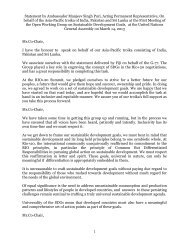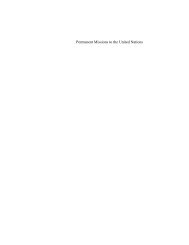STATE OF THE WORLD'S CITIES 2012/2013 Prosperity
STATE OF THE WORLD'S CITIES 2012/2013 Prosperity
STATE OF THE WORLD'S CITIES 2012/2013 Prosperity
Create successful ePaper yourself
Turn your PDF publications into a flip-book with our unique Google optimized e-Paper software.
State of the World’s Cities <strong>2012</strong>/<strong>2013</strong><br />
POLICy<br />
Cities that<br />
reevaluate<br />
their notion of the public<br />
and thereby provide green<br />
areas, parks, recreation<br />
facilities and public spaces<br />
demonstrate a commitment<br />
to improved quality of life.<br />
POLICy<br />
Cities that<br />
enhance and<br />
sustain the use of public<br />
space have enhanced<br />
community cohesion, civic<br />
identity and quality of life.<br />
Box 2.3.3<br />
Greenery and Quality of Life in Asian Cities<br />
In Amman, parks<br />
represent 12 per cent of the total land area; however, in<br />
the eastern part of the city, with the highest population<br />
density, open spaces are very scarce. 28 In some other cities,<br />
Internet café, Maroc telecom, and teleboutique signs in Morocco.<br />
Access to the Internet is now a vital asset for both poor and rich.<br />
© <strong>2012</strong> Alistair Laming/fotoLIBRA.com<br />
Many cities across the developing world, especially in Asia and the Arab States, are creating new<br />
parks in an effort to meet international standards for green area per capita (i.e., eight square meters<br />
per head). 32 In the past five years, Shenzhen has created 435 new parks as part of the “Eco-city<br />
Programme” and the “Garden City Plan”, achieving a ratio of 16.3 sqm in 2009. As a result, the<br />
urban ecological environment in Shenzhen has gradually improved and with it quality of life. 33 Also<br />
in China, Chongqing has increased the combined green belt and public square surface area by a<br />
multiple of 16 in the last 30 years. 34 The state-city of Singapore is a leading example in the world,<br />
with greenery over 50 per cent of the surface area and over 450 public parks and gardens. The city<br />
is also preserving its rich biodiversity with four nature reserves which cover more than 3.000 ha, and<br />
are legally protected to safeguard key indigenous ecosystems. These initiatives contribute to a cleaner<br />
environment, shaping the country’s landscape and enhancing quality of life. Recently, greenery has<br />
been given even more emphasis, with a new plan for a “City-In-a-Garden”’. 35<br />
66<br />
particularly those aiming at ‘world-class’ status, parks and<br />
‘green’ spaces have a more ornamental or ‘image’ role than<br />
a real ‘public good’ one.<br />
Parks and ‘green’ spaces have always been associated<br />
with better quality of urban life. In Praia, a city where<br />
such spaces are very scarce, a newly opened, small public<br />
square has become a major place for recreation, leisure<br />
and socialization despite its reduced dimensions. 29 In<br />
Guadalajara, Mexico, temporary appropriation of streets<br />
and public spaces for pedestrian and cycling purposes has<br />
become extremely popular. As a result, this recreational<br />
project, known as ‘vía recreativa’, has been extended<br />
Box 2.3.4<br />
Internet, Information and Quality of Life<br />
Basic needs are rapidly changing. Access to Internet is<br />
increasingly becoming an essential component of quality<br />
of life. In many cities today, Internet is used not just to<br />
communicate, socialize and learn, but also to promote public<br />
participation and to assess citizens’ perceptions of urban<br />
affairs. Formal recognition of right to information (i.e., India,<br />
2005; the Philippines, 2008; South Africa, 2000) empowers<br />
citizens and encourages participation in governance and<br />
government programmes. The cities of Hyderabad, Cebu,<br />
and Johannesburg, amongst many others, are introducing<br />
e-governance to enable many services on-line − issuance<br />
of documents, payments, ticketing, applications and<br />
complaints − as a major step to enhance quality of life. In<br />
India more than 500 million cell phones are currently in use,<br />
and many with reduced call rates. This is improving the<br />
connectivity of poor and rich alike, and enhancing economic<br />
opportunities for the urban poor. As stated by a local expert in<br />
India, “Internet is an empowerment tool”.




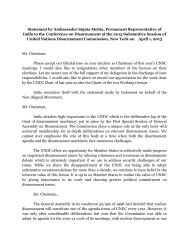
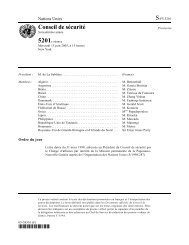
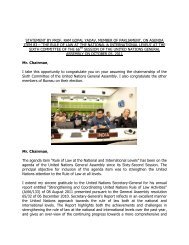
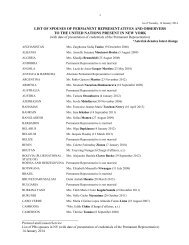
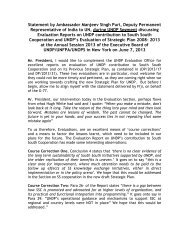
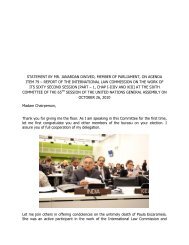
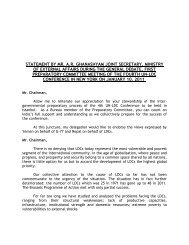
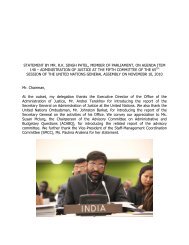

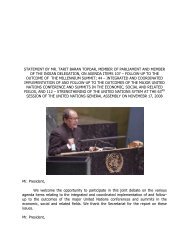
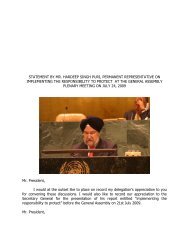
![1 statement by dr.[mrs] kakoli ghosh dastidar - Member States Portal](https://img.yumpu.com/27526598/1/190x245/1-statement-by-drmrs-kakoli-ghosh-dastidar-member-states-portal.jpg?quality=85)
